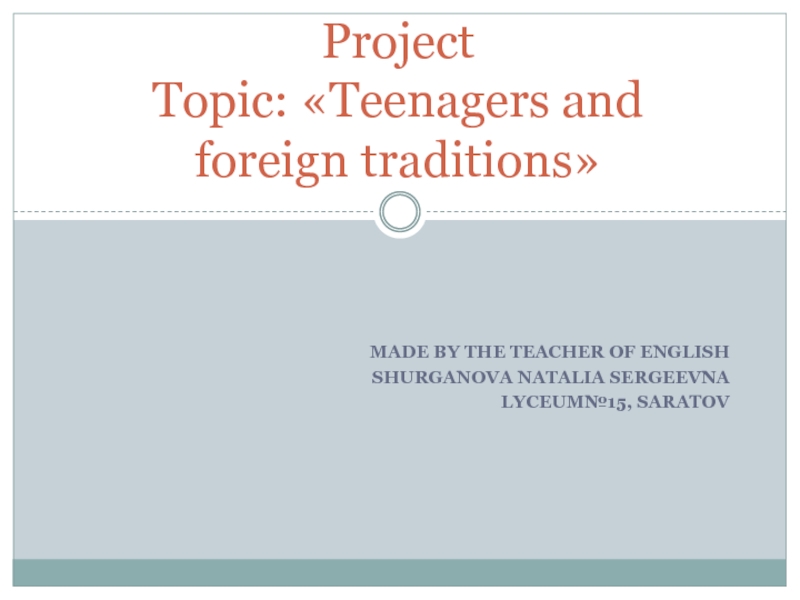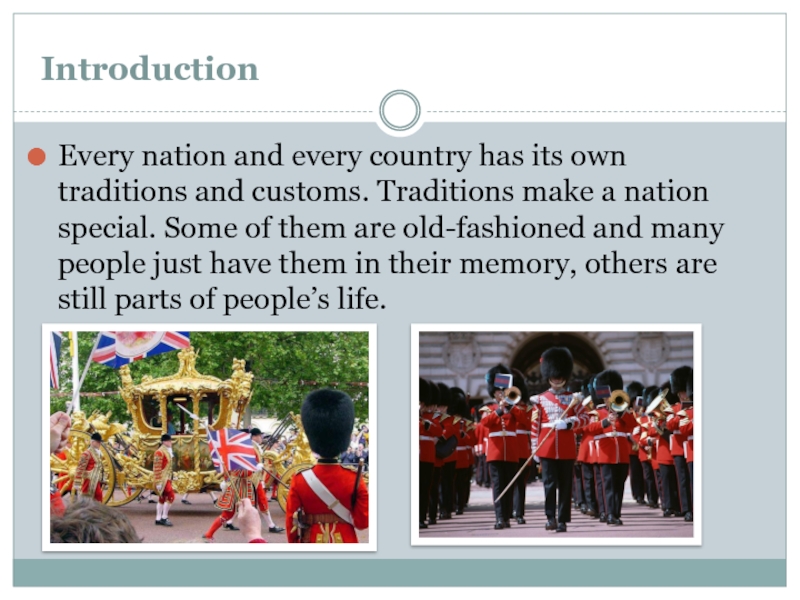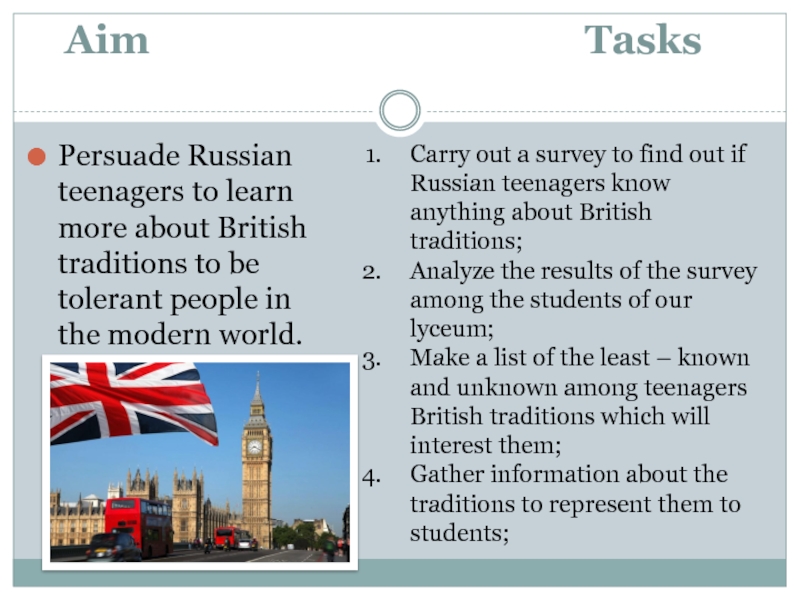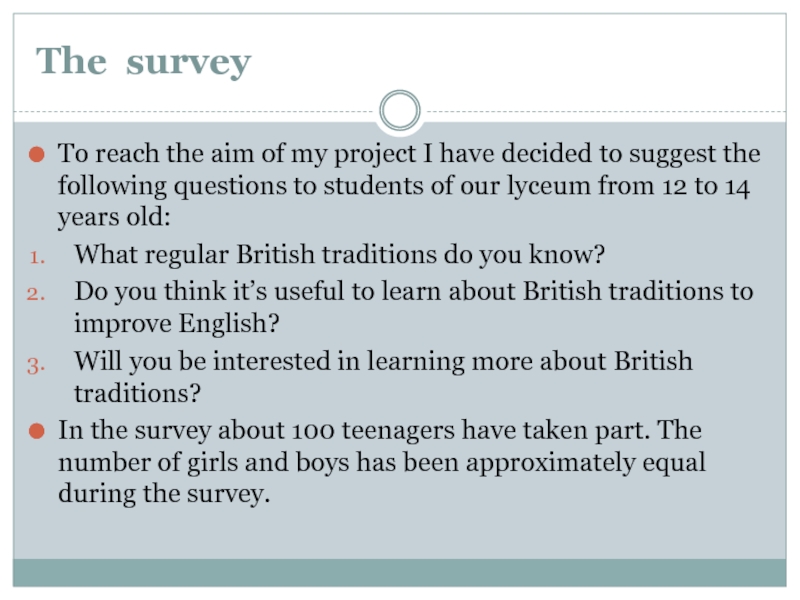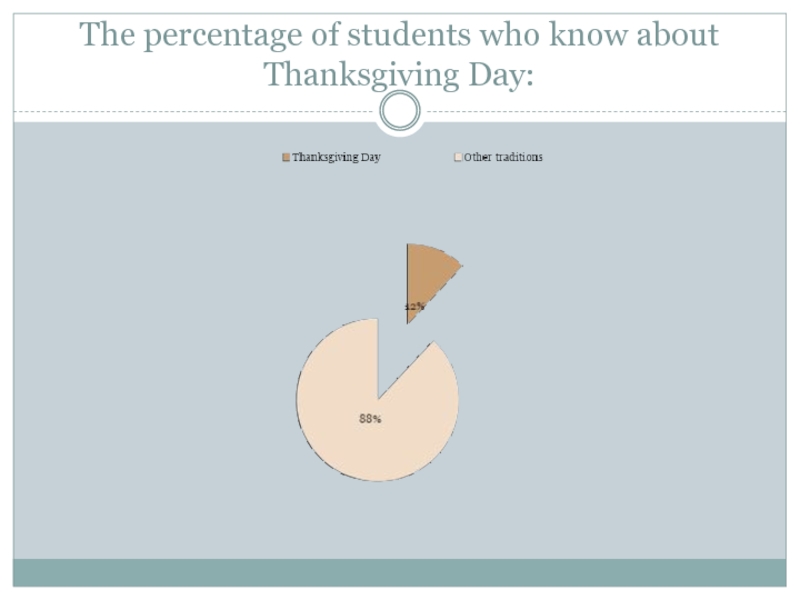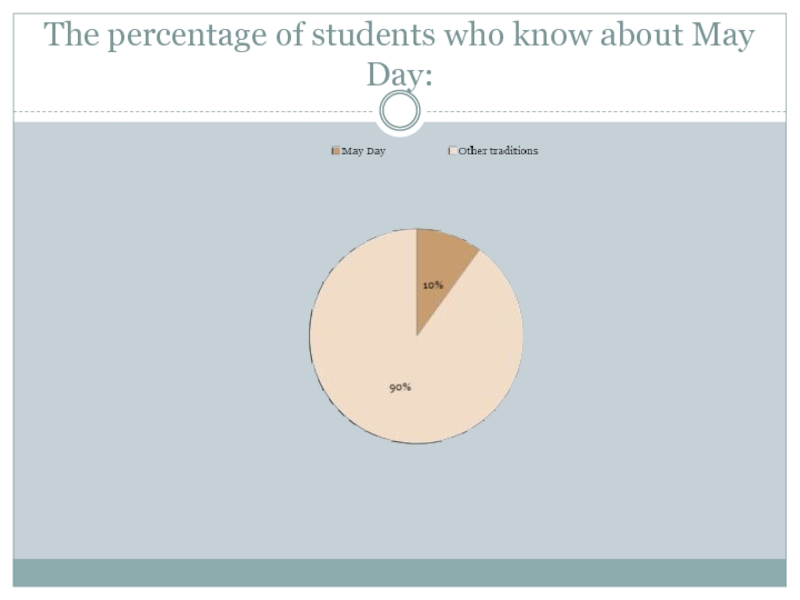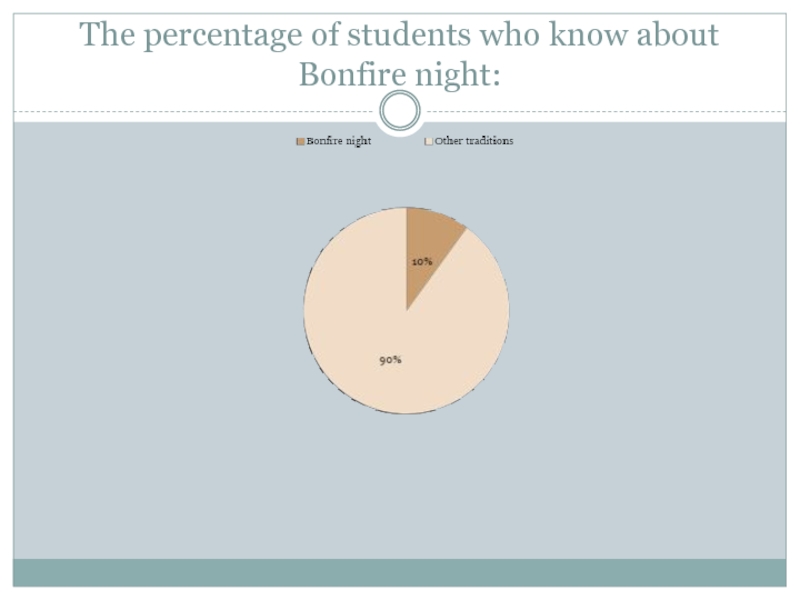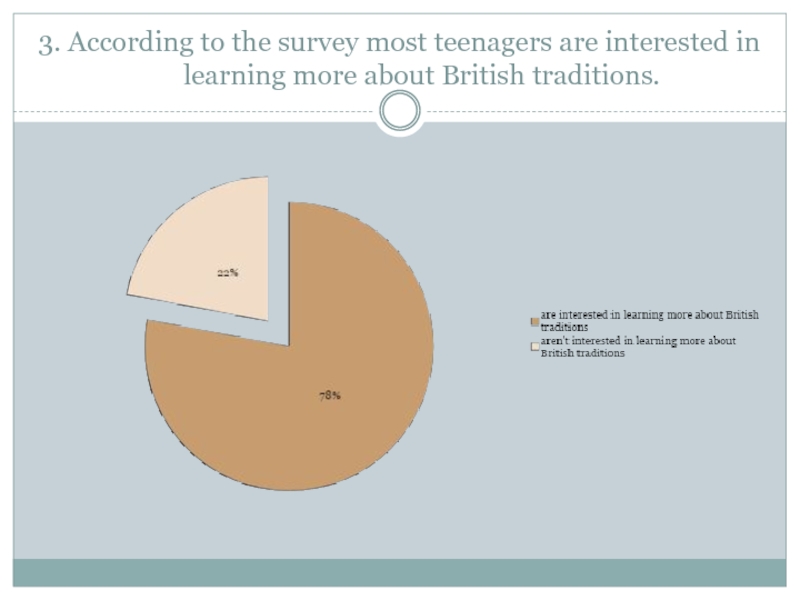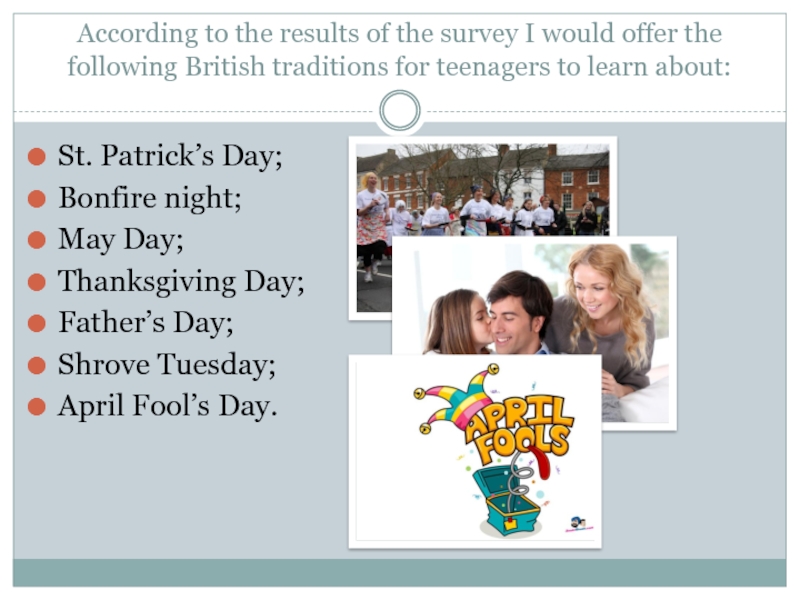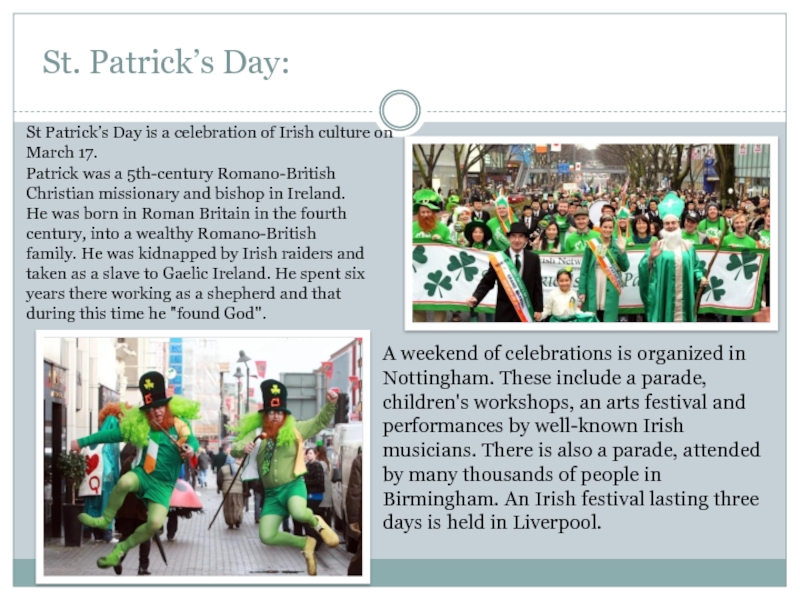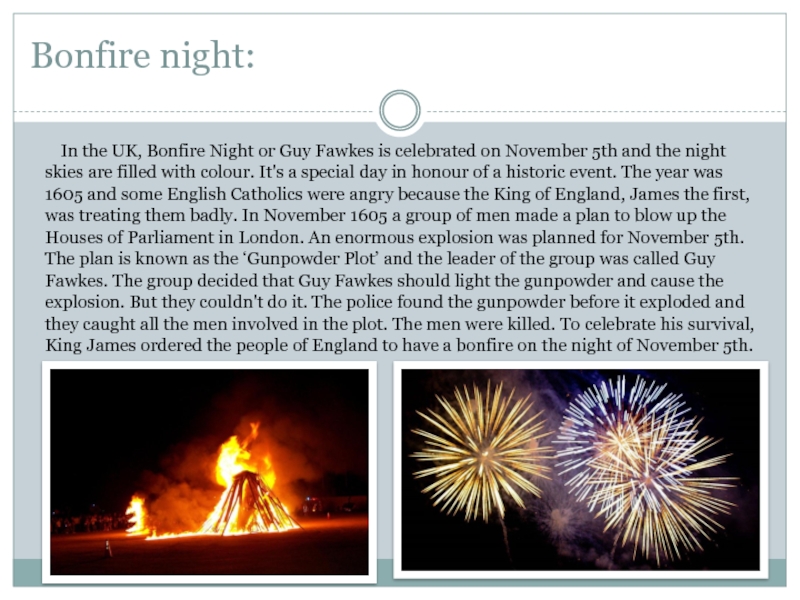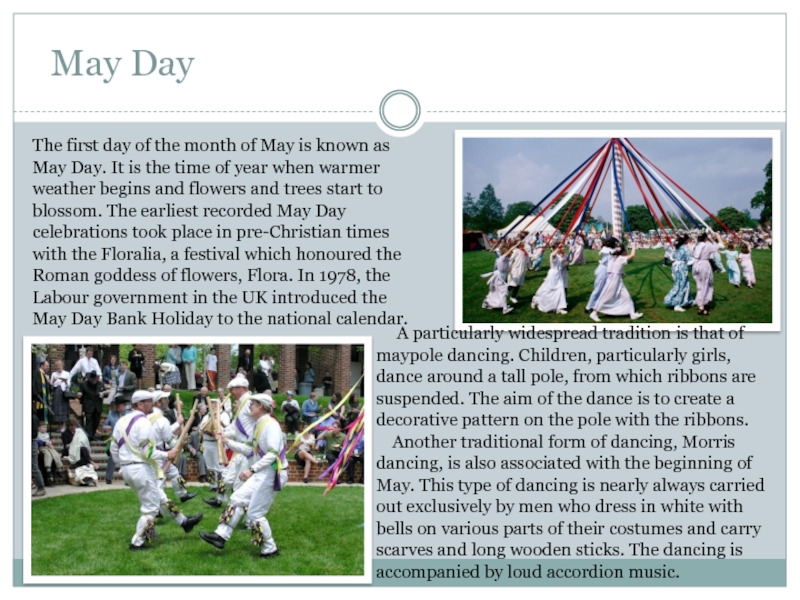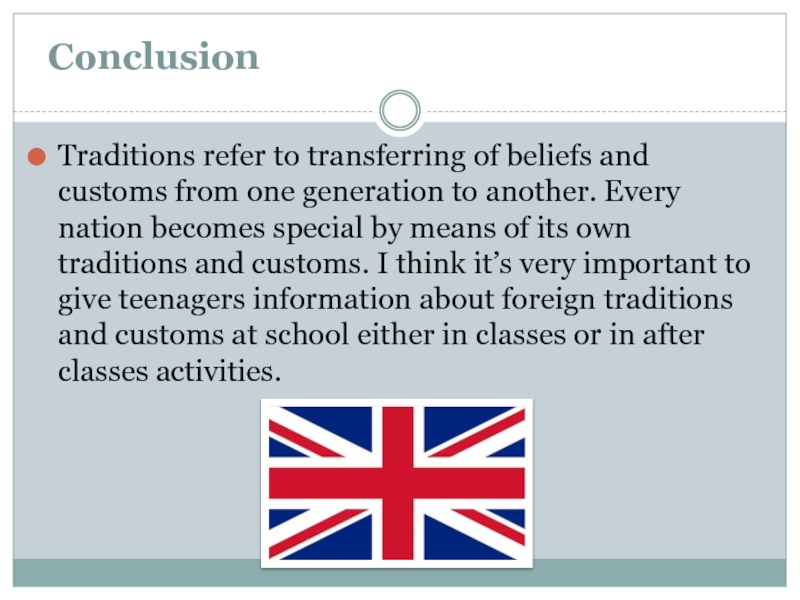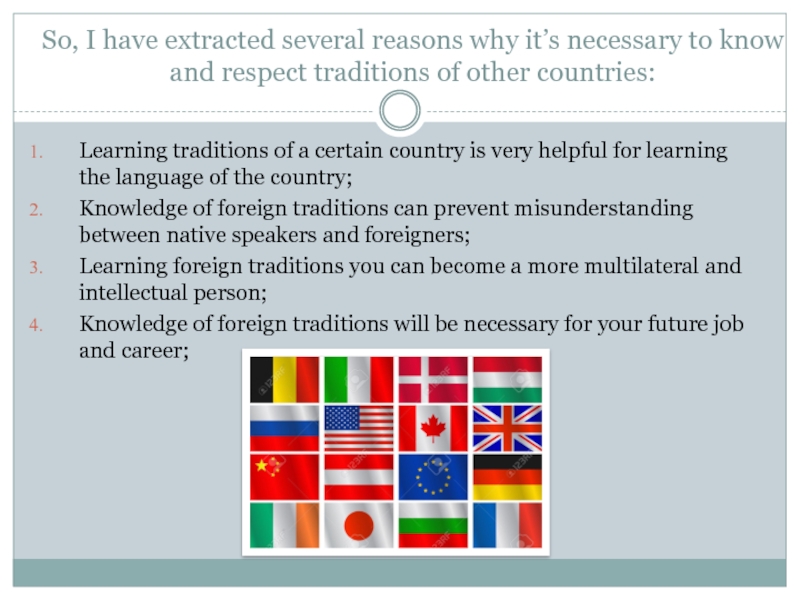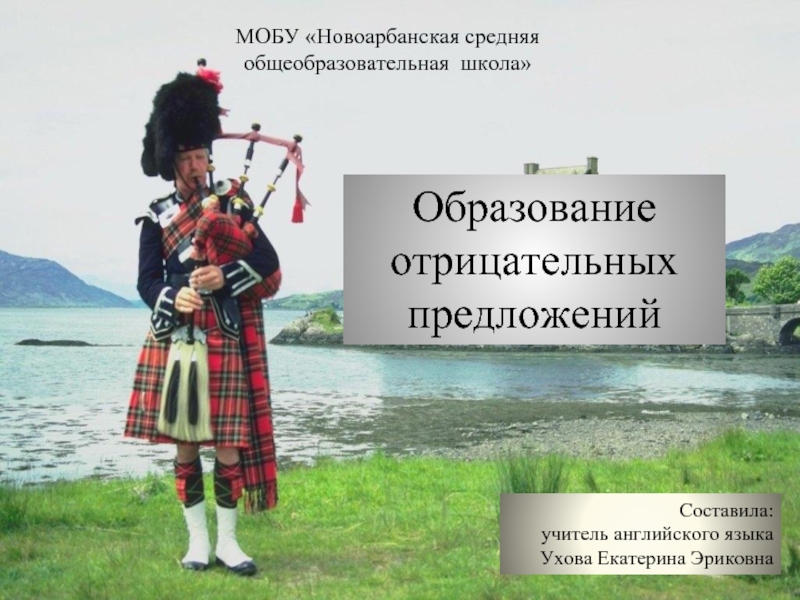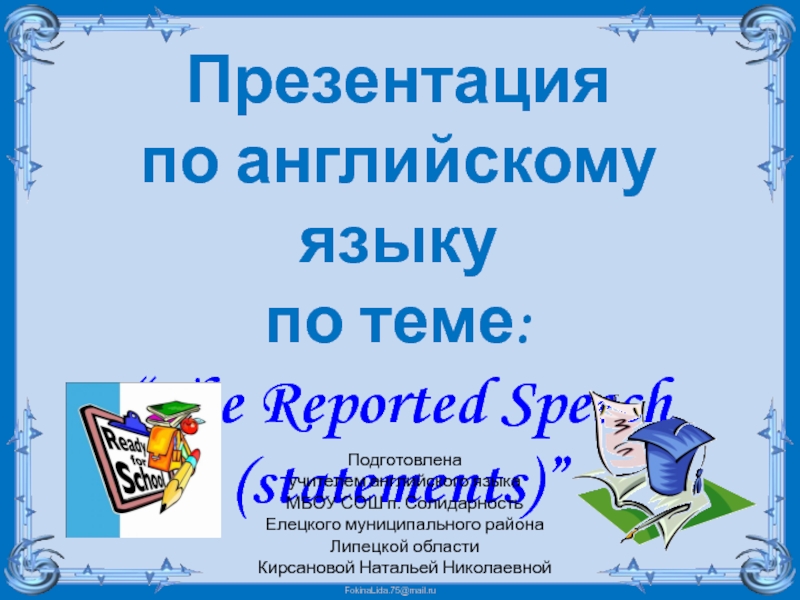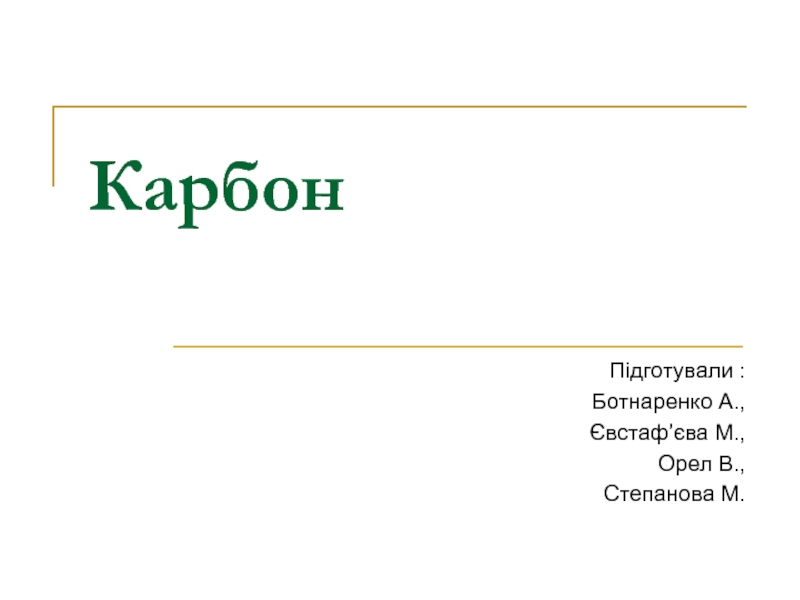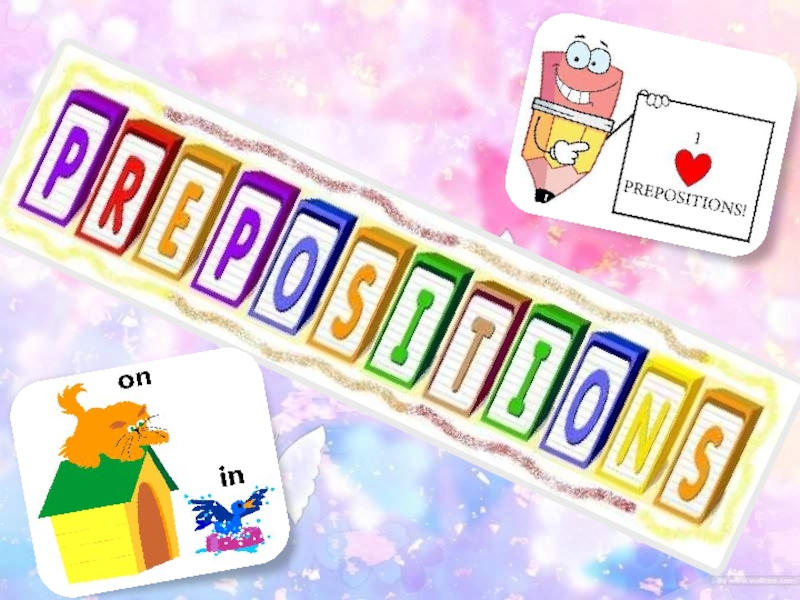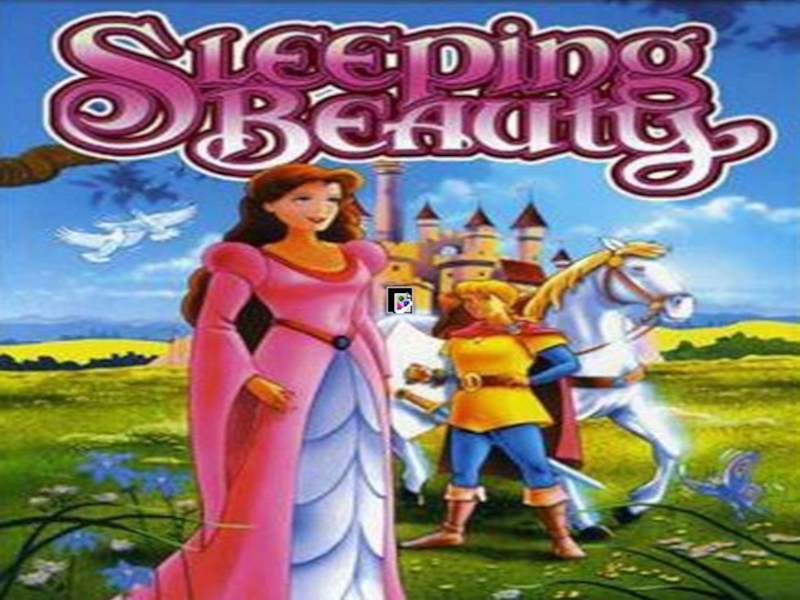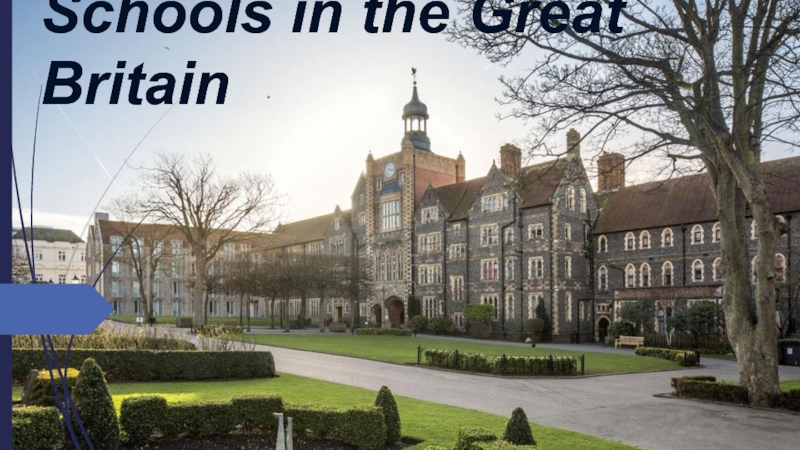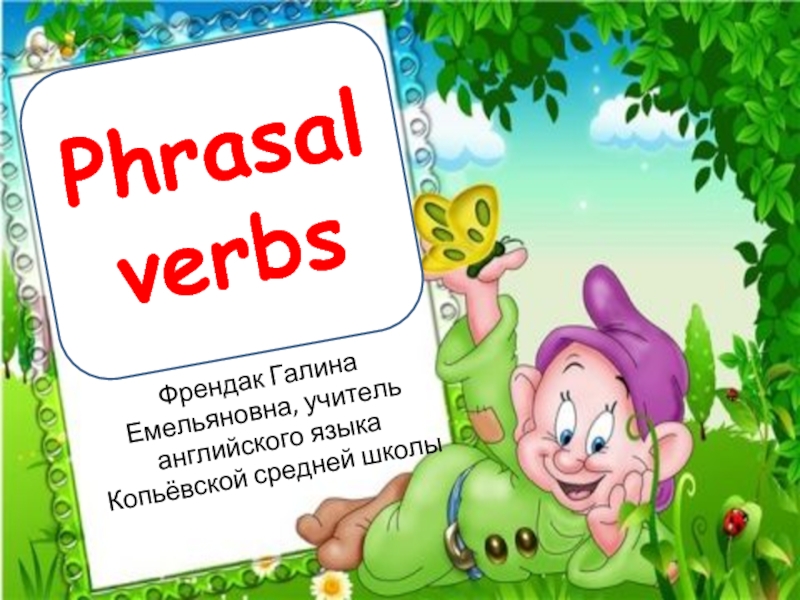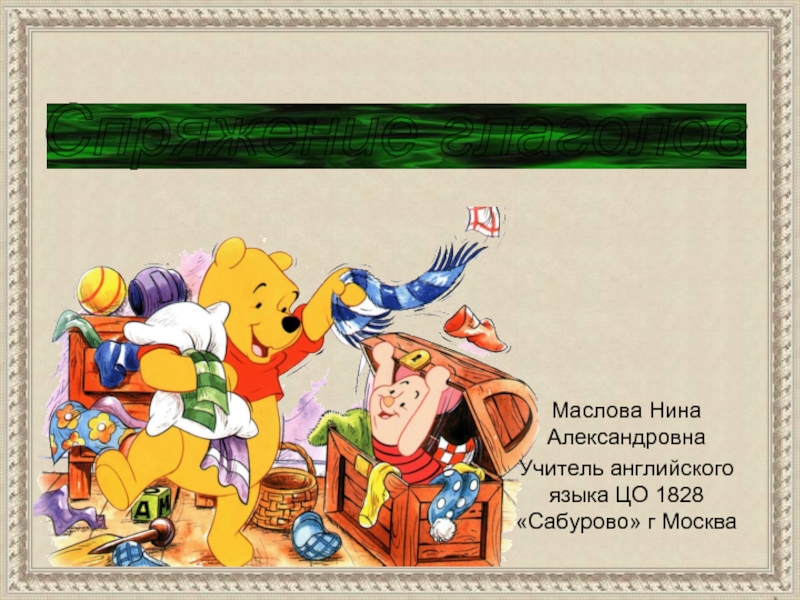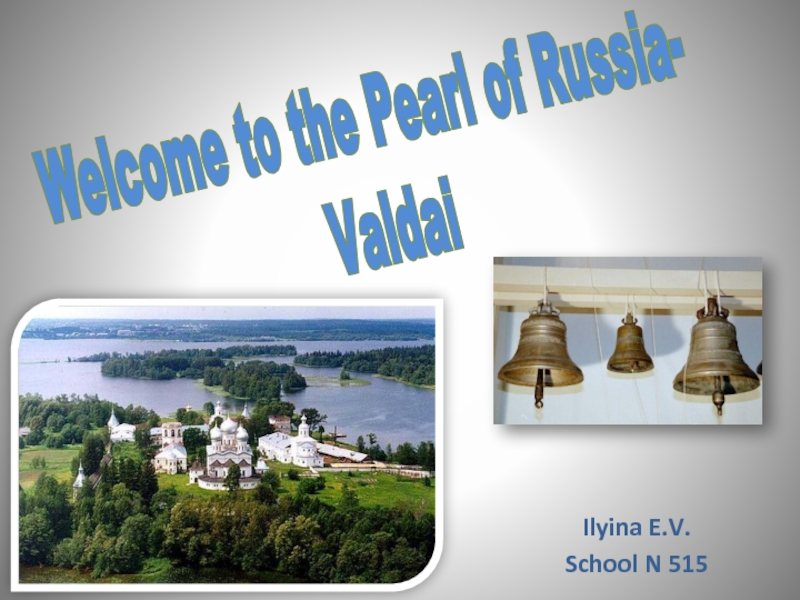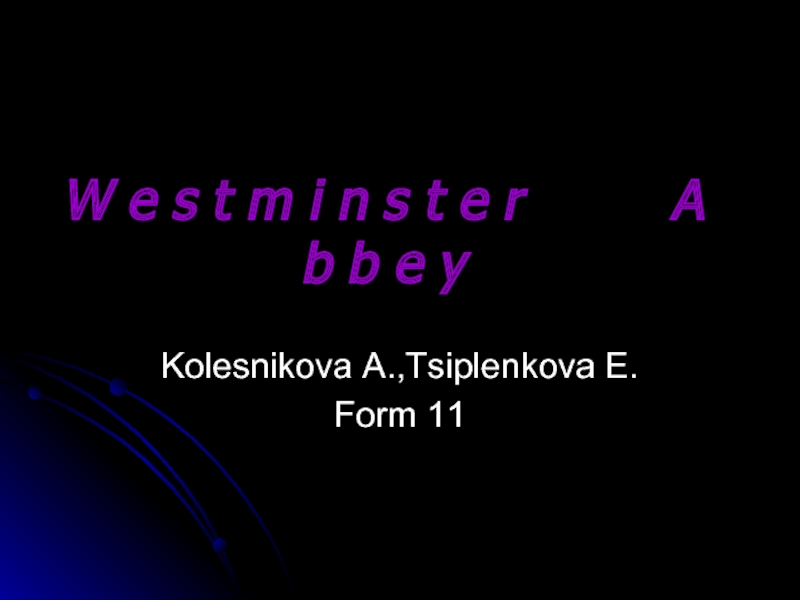Разделы презентаций
- Разное
- Английский язык
- Астрономия
- Алгебра
- Биология
- География
- Геометрия
- Детские презентации
- Информатика
- История
- Литература
- Математика
- Медицина
- Менеджмент
- Музыка
- МХК
- Немецкий язык
- ОБЖ
- Обществознание
- Окружающий мир
- Педагогика
- Русский язык
- Технология
- Физика
- Философия
- Химия
- Шаблоны, картинки для презентаций
- Экология
- Экономика
- Юриспруденция
Презентация к уроку "Подростки и праздники англоязычных стран"
Содержание
- 1. Презентация к уроку "Подростки и праздники англоязычных стран"
- 2. Introduction Every nation and
- 3. Problem There is a lot of misunderstanding
- 4. Aim
- 5. The survey To reach the aim
- 6. Results of the survey According to the
- 7. The percentage of students who know about Merry Christmas:
- 8. The percentage of students who know about Halloween:
- 9. The percentage of students who know about Thanksgiving Day:
- 10. The percentage of students who know about May Day:
- 11. The percentage of students who know about Bonfire night:
- 12. The percentage of students who know about St. Patrick Day:
- 13. 2. According to the survey most teenagers
- 14. 3. According to the survey most teenagers are interested in learning more about British traditions.
- 15. According to the results of the survey
- 16. St. Patrick’s Day: Patrick was a 5th-century
- 17. Bonfire night: In the UK, Bonfire Night
- 18. May DayThe first day of the month
- 19. Thanksgiving Day:Thanksgiving Day can be traced back
- 20. Conclusion Traditions refer to transferring of
- 21. So, I have extracted several reasons why
- 22. Скачать презентанцию
Слайды и текст этой презентации
Слайд 1Made by the teacher of english
Shurganova Natalia Sergeevna
Lyceum№15, saratov
Project
Topic:
«Teenagers and foreign traditions»
Слайд 2
Introduction
Every nation and every country has its own traditions and
customs. Traditions make a nation special. Some of them are
old-fashioned and many people just have them in their memory, others are still parts of people’s life.Слайд 3Problem
There is a lot of misunderstanding between people around the
world nowadays. This leads to conflicts and even wars between
countries and nations. What can we do to make the world less strained and stressful?Слайд 4Aim
Tasks
Persuade Russian teenagers to learn more about British traditions to be tolerant people in the modern world.
Carry out a survey to find out if Russian teenagers know anything about British traditions;
Analyze the results of the survey among the students of our lyceum;
Make a list of the least – known and unknown among teenagers British traditions which will interest them;
Gather information about the traditions to represent them to students;
Слайд 5The survey
To reach the aim of my project I
have decided to suggest the following questions to students of
our lyceum from 12 to 14 years old:What regular British traditions do you know?
Do you think it’s useful to learn about British traditions to improve English?
Will you be interested in learning more about British traditions?
In the survey about 100 teenagers have taken part. The number of girls and boys has been approximately equal during the survey.
Слайд 6Results of the survey
According to the survey the most students
know only about two traditions: Merry Christmas and Halloween. The
least - known British traditions among teenagers are: St. Patrick Day, Bonfire night, May Day, Thanksgiving Day.Слайд 132. According to the survey most teenagers think it’s useful
to learn more about British traditions to improve English.
Слайд 143. According to the survey most teenagers are interested in
learning more about British traditions.
Слайд 15According to the results of the survey I would offer
the following British traditions for teenagers to learn about:
St. Patrick’s
Day;Bonfire night;
May Day;
Thanksgiving Day;
Father’s Day;
Shrove Tuesday;
April Fool’s Day.
Слайд 16St. Patrick’s Day:
Patrick was a 5th-century Romano-British Christian missionary and
bishop in Ireland. He was born in Roman Britain in
the fourth century, into a wealthy Romano-British family. He was kidnapped by Irish raiders and taken as a slave to Gaelic Ireland. He spent six years there working as a shepherd and that during this time he "found God".A weekend of celebrations is organized in Nottingham. These include a parade, children's workshops, an arts festival and performances by well-known Irish musicians. There is also a parade, attended by many thousands of people in Birmingham. An Irish festival lasting three days is held in Liverpool.
St Patrick’s Day is a celebration of Irish culture on March 17.
Слайд 17Bonfire night:
In the UK, Bonfire Night or Guy Fawkes is
celebrated on November 5th and the night skies are filled
with colour. It's a special day in honour of a historic event. The year was 1605 and some English Catholics were angry because the King of England, James the first, was treating them badly. In November 1605 a group of men made a plan to blow up the Houses of Parliament in London. An enormous explosion was planned for November 5th. The plan is known as the ‘Gunpowder Plot’ and the leader of the group was called Guy Fawkes. The group decided that Guy Fawkes should light the gunpowder and cause the explosion. But they couldn't do it. The police found the gunpowder before it exploded and they caught all the men involved in the plot. The men were killed. To celebrate his survival, King James ordered the people of England to have a bonfire on the night of November 5th.Слайд 18May Day
The first day of the month of May is
known as May Day. It is the time of year
when warmer weather begins and flowers and trees start to blossom. The earliest recorded May Day celebrations took place in pre-Christian times with the Floralia, a festival which honoured the Roman goddess of flowers, Flora. In 1978, the Labour government in the UK introduced the May Day Bank Holiday to the national calendar. A particularly widespread tradition is that of maypole dancing. Children, particularly girls, dance around a tall pole, from which ribbons are suspended. The aim of the dance is to create a decorative pattern on the pole with the ribbons.
Another traditional form of dancing, Morris dancing, is also associated with the beginning of May. This type of dancing is nearly always carried out exclusively by men who dress in white with bells on various parts of their costumes and carry scarves and long wooden sticks. The dancing is accompanied by loud accordion music.
Слайд 19Thanksgiving Day:
Thanksgiving Day can be traced back to the 1621
celebration at the Plymouth Plantation, where the religious refugees from
England known popularly as the Pilgrims invited the local Native Americans to a harvest feast after a particularly successful growing season. The previous year's harvests had failed and in the winter of 1620, half of the pilgrims had starved to death.Luckily for the rest, members of the local Wampanoag tribe taught the Pilgrims how to grow corn, beans and squash, catch fish, and collect seafood.
On this day, the churches are decorated with products such as home-grown plants, fruits and vegetables to show gratitude to the almighty. The occasion includes turkey, mashed potatoes, cranberries and olives. Children sing hymns and distribute fruits and vegetables to their friends. The celebration is enjoyed by singing songs and by giving away fruits and vegetables. Often the food is distributed among the poor people of the local community. The home-grown products are also used to raise funds for the church, or charity.
Слайд 20Conclusion
Traditions refer to transferring of beliefs and customs from
one generation to another. Every nation becomes special by means
of its own traditions and customs. I think it’s very important to give teenagers information about foreign traditions and customs at school either in classes or in after classes activities.Слайд 21So, I have extracted several reasons why it’s necessary to
know and respect traditions of other countries:
Learning traditions of a
certain country is very helpful for learning the language of the country;Knowledge of foreign traditions can prevent misunderstanding between native speakers and foreigners;
Learning foreign traditions you can become a more multilateral and intellectual person;
Knowledge of foreign traditions will be necessary for your future job and career;
